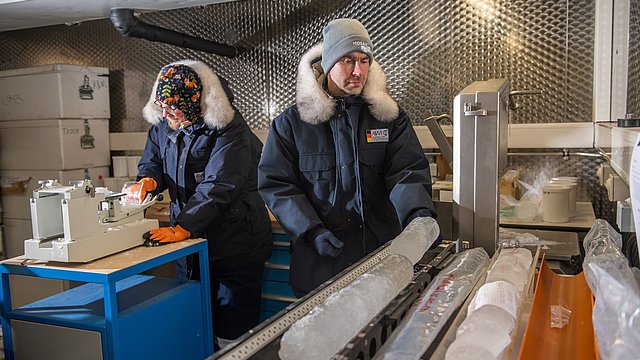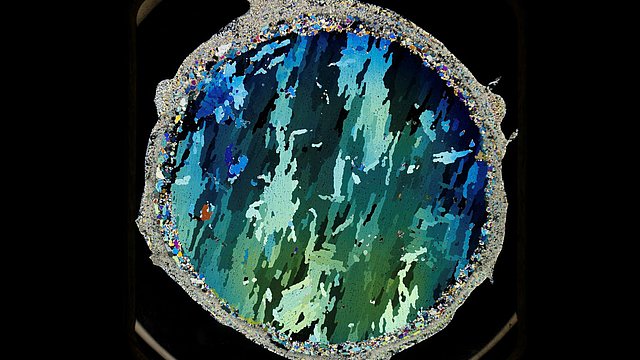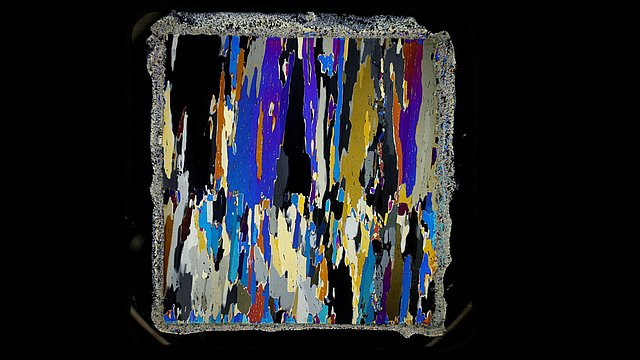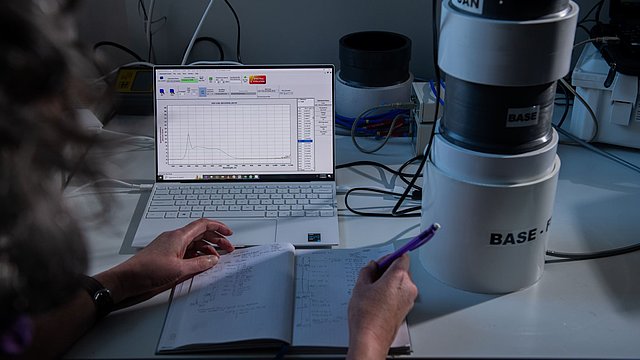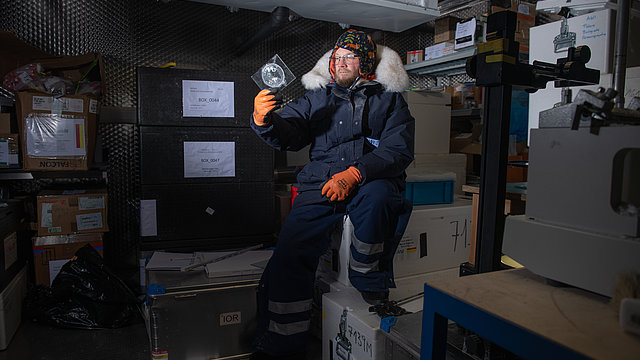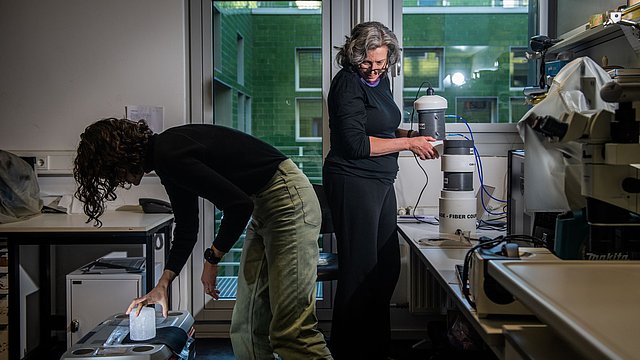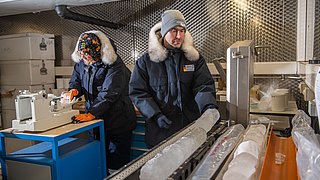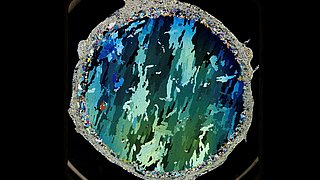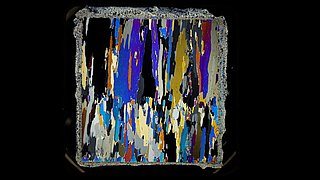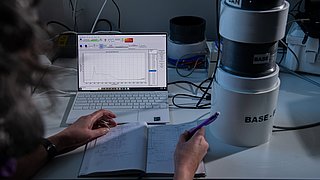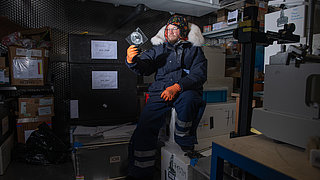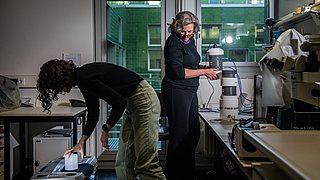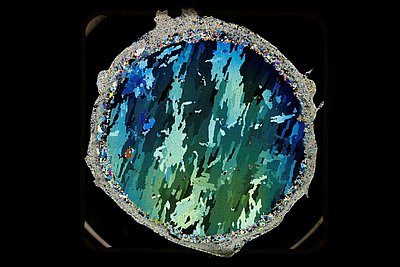Sea ice cores from the MOSAiC expedition (2019-2020) are one of the treasures that were brought back to Bremerhaven at the end of the year-long Arctic drift in October 2020. Now, a group of scientists from different partner institutions have come to Bremerhaven to process a major fraction of the core samples and analyze their physical properties. The researchers aim to better understand the growth history of the sea ice and its internal optical properties. This will help them better understand the seasonal changes of the ice cover over its lifetime.
The small-scale properties of sea ice tell a lot about its history and the atmospheric and oceanographic conditions that the ice experienced since its formation. Analyzing sea ice cores for these small-scale properties is a classic method in sea ice research. The physical, chemical, and ecological properties build the baseline for many related analyses. They are also of inherent interest for the details they reveal about the sea ice itself.
During the MOSAiC expedition, sea ice coring was one of the most cross-disciplinary activities with a particularly high level of coordination. The “coring Monday” became a well-established routine for retrieving ice cores from two different ice types every week. “It took us many meetings to agree on routines and parameters for the ice core work, because of the many and very diverse needs. Finding this agreement and realizing this effort across the different teams on board was one of the main successes of MOSAiC already in the field”, explains Marcel Nicolaus (AWI), who was responsible for the sea ice work during MOSAiC. In the field, the team took between 20 and 50 ice cores from a very small area each Monday, spending the entire day on the ice. Most ice cores were melted and processed directly onboard RV Polarstern during the expedition, but some cores were brought back frozen for later analyses and archive. As a result, more than 70 boxes with 240 ice cores are currently stored in the ice core archive in Bremerhaven waiting for analysis.
Now, in January and February 2023, a major activity started to analyze sea ice texture and optical properties, following up some initial work in May 2022. For this, sea ice experts from the University of Alaska in Fairbanks (UAF), the University of Washington Polar Science Center (UW), the Woods Hole Oceanographic Institution (WHOI) and the University of Hamburg came to Bremerhaven to work in the freezer laboratories at the Alfred Wegener Institute (AWI). This work is also supported by colleagues of the Norwegian Polar Institute and the Alfred Wegener Institute. For the ice core processing and additional experiments, different room temperatures are needed and thus three laboratories are used: one at temperatures constant at -20°C for sea ice thin section and ice core preparations, one with adjustable temperatures between -1°C and -15°C and one at room temperature (+19°C). For the adjustable temperatures, the original freezer lab container from the MOSAiC expedition, which is usually only used at sea, was installed outside the AWI building.
Sea ice texture, primarily defined as ice crystal structure and size, could be observed by preparing “thin sections”: First, the ice core is cut with a band saw in vertical samples of 10 cm length. Second, a horizontal slice is cut at the bottom extremity of each vertical sample, then a vertical slice is cut in the middle of the sample. Horizontal and vertical slice are easily differentiable, as the first one is circular and the second one is rectangular. Third, each slice is frozen to glass plates and shaved on a sliding microtome until they reach a thickness below 0.5 mm. Thin sections are then photographed and analyzed under cross-polarized light, such that each crystal appears in a different color. Marc Oggier (UAF) explains, “we plan to process between 15 and 20 m of sea ice cores, resulting in more than 250 samples over the coming four weeks. Beside the scientific analyses that shade light on all the hidden ice processes, I love the impressive photographs of sea ice thin sections, showing the ice crystals in fascinating colors.”
The optical properties of sea ice determine how sunlight incident on the ice is reflected back to the atmosphere, absorbed within the ice, and transmitted into the ocean beneath. While direct measurement of the albedo (reflected portion) and transmittance occurs strictly on the ice, the work being carried out in the lab focuses on the inherent properties of the sea ice itself. For the analyses, ice cores are cut into 10 cm long samples, which are analyzed piece by piece. Maddie Smith (WHOI) explains: “We perform the analyses at different temperatures as the optical properties of the ice are known to depend on temperature. While we have to keep the samples at -20 °C for storage and long-term preservation, we bring them back to their sampling temperature for laboratory measurements”. To estimate the properties of the ice that determine how it divides light, samples are illuminated from the top in a dark cylinder and the amount of light that exits the sample is measured with a spectroradiometer. This technique permits observation of the total amount of light that passes through the sample as well as the color of this light. Knowing the color can be informative for deriving the constituents in the ice, e.g., biomass and sediments. Bonnie Light (UW) adds: “The sea ice cores from the MOSAiC expedition provide a unique opportunity to measure the optical properties of first-year and second-year sea ice that have undergone the same annual growth history. We expect to see evidence that light transmittance differs between first-year and second-year ice due to differences in internal scattering associated to their typical texture.” Combined results from the analysis will be used to refine models of sea ice optics and the Arctic energy budget.
After the freezer lab work in Bremerhaven, the researchers will continue to analyze the spectra and photographs. These results will be merged with other measurements, e.g., from the surface and under the ice. This work will yield an improved understanding of how sea ice interacts with sunlight. Combined results from the analysis will be used to refine models of sea ice optics and the Arctic energy budget. Preliminary results from the first phase of the project will be presented at the second MOSAiC science conference and workshop in Boulder, Colorado, USA, starting right after the lab work on 13 February 2023.
“I am very happy and proud that we succeeded collecting this sea ice core data set over the entire MOSAiC year in the field” says Marcel Nicolaus. He continues “it’s a real pleasure to see that all samples are in excellent condition and that we were able to coordinate this common work and analyses here in Bremerhaven. Seeing all these cores brings back a lot of memories of the field work and the time out in the Arctic”.
Contact
- Dr Marcel Nicolaus
-
Dr Mark Oggier (UAF)
-
Dr Maddie Smith (WHOI)
-
Dr Bonnie Light (UW)
Questions?
Contact us by E-Mail or use our contact form.
